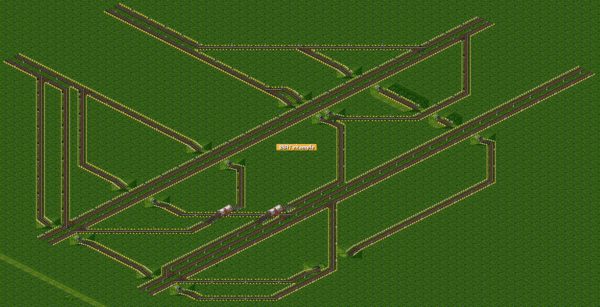Mainline Junctions
From #openttdcoop wiki
<< Basic Junctions | Networking >>
After building the first hubs in Part 2, you will probably notice that our mainlines may sometimes cross each other. Since we always build a comprehensive network and try to avoid dead-end lines, there is a point in the game where a so-called "Backbone Hub" is needed (remember to name the hub as described before). To see what we talk about, look at this:

Let us analyse this one:
- A mainline is built from east to west (if you read the previous pages carefully you should already know where east and west are). Be careful: this mainline has a temporary solution: we usually don't build tunnels on mainlines (since we can't signal tunnels!). This town has got to move to ... somewhere else in the close future. Also, we do not use bridges or something else. But let us leave this drawbacks beside and move the focus back on the BBH itself.
- Again, we have a T-Hub but this time it is slightly different: we do not connect a sideline (LR) to a mainline (LL___RR) but a mainline to a mainline.
- Mainlines enjoy the highest priority in the whole network. Mainlines are intended to be fast and hosting trains in order to go over long distances. Therefore, we try to avoid slowing down these trains on mainlines (remember: money has something to do with time and time is money!). In the end we come to the conclusion: Backbone Hubs have to be as fast as ever possible! As shown in our tutorial picture, there are no tight curves or major slopes. It is - as already shown - signaled as close as possible to avoid delays (not completely done in our example).
- Since a train typically has a route (notice: not order list!) like Station XY - Sideline Hub YZ - Backbone Hub ZA - Sideline Hub AB - Station BC, it has already the possibility to access both (i.g.: all) tracks of the mainline via the Sideline Hubs (remember: for SLH's we said: always connect every possibility!) we do not need to connect each track of one mainline to each track of the other mainline - which simplifies the whole thing a lot! You only need to connect the inner line of one mainline to the inner line of the other mainline and so one. Feel free to study our tutorial picture some minutes and you'll find out what we mean.
- The best start if you want to build a BBH is to move the tracks of one direction some spaces to have more space in between the tracks. You'll soon notice that this is a quite helpful trick.
Additional comments by Xahodo:
- Always split before you join tracks, otherwise you might be creating a roundabout or (even worse) a cloverleaf junction. These junction types will jam once they see enough traffic from several directions.
Additional comments by Mucht:
- Don't mix that with join before split which has to be avoided by any means!